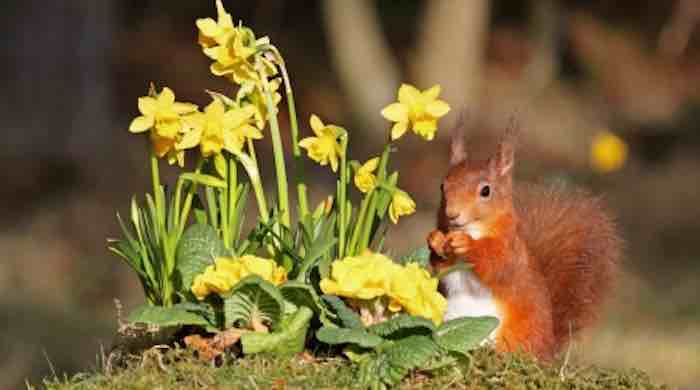By Wes Porter ——Bio and Archives--September 1, 2019
Lifestyles | CFP Comments | Reader Friendly | Subscribe | Email Us

Bad enough for a scurry of squirrels to rip tulip flowers apart in a spree of vandalism every spring, but then urban deer invade to snack on them. And, of course, no sooner have fresh tulip bulbs been planted this fall than the wretched rodents dig them up. This past March, Britain’s famous Royal Horticultural Society took matters in hand to advise gardeners to abandon tulips in favour of daffodils. All daffodils are botanically Narcissus. They are also poisonous. Not surprisingly, squirrels, deer, mice and other pests shun them.
A group of Japanese scientists has discovered a new orchid species on Japan’s subtropical islands of Amami-Oshma and Tokunoshima that bears fruit without once opening its flowers. They named the new species Gastrodia amamiana, and the findings were published on the online edition of Phytotaxa.
Not everyone is ready to surrender to squirrels. At least two U.S. presidents positively doted on them – cooked that is. William Henry Harrison (ninth president) preferred his squirrel in a stew. For 20th President James Garfield it was squirrel soup before, that is, he was assassinated after just six months in office. President Eisenhower, furious at the rascally rodents digging holes in his White House putting green, wanted to shoot them. He was dissuaded upon advice that gun shots would create alarm. In some countries, squirrels is highly esteemed as game. It is cooked in the same way as rabbit, advises the Larousse Gastronomique. Back in the U.S. of A., Brunswick Stew consists of squirrel, corn, onions tomatoes, lima beans, and a dash of cayenne pepper, according to that font of information Rebecca Rupp.
Diversion No. 2Within a shrouded New Zealand forest a kauri tree stump keeps itself alive by holding onto the roots of its neighbouring trees, exchanging water and resources through the grafted root system. Now research, published in iScience, details how the surrounding trees keep the stump alive, possibly in exchange for access to larger root systems. The findings suggest a shift from the perception of trees as individuals towards understanding forest ecosystems as ‘superorganisms.’
In subtropical Florida, light levels are measured at several thousand foot-candles. Up in the Great White North, it will deteriorate into the high hundreds as the days shorten. Yet light can be improved in a number of ways. First and foremost, clean the windows. Human eyes adjust to the loss of perhaps 40% such light. Plants, requiring photosynthesis, cannot. Nor do grime-coted leaves help. A daily spritz with tepid water will help keep them clean. It also discourages that infuriating pest, the sap-sucking spider mite. Electric light is essential to modern human life. How much it assist plants unless close to them is debateable. But the modern ‘curlies’ and LED bulbs certainly help, especially for indoor plants which tolerate shade conditions.
Roses grow to twice their usual size at the Royal Horticultural garden in Wisley after experts discover the secret to magnificent blooms – spraying them with concentrated essence of garlic. It wards of the bane of many rose-grower’s life: black spot, explained The Daily Mail, which fails to mention any change in aroma.
P. G. Wodehouse assured that he would not reveal the slugs in your salad days. Researchers have not been so inhibited. A recent report in the journal Science Advances suggests there might be some unexpected intrusions into your prepackaged produce. At least one expert advises that to avoid botulism he never purchases such or other pre-prepared foods. After examining 40 samples bagged lettuces, spinach and cut green beans, the scientists listed mainly frogs (21) but also rodents, snakes, lizards, birds and even a bat – but no slugs. This is said to be the first ever review. Undoubtedly it will not be the last. Meanwhile, bon appetite!
Diversion No. 4Adults who eat more than 50g of chili pepper a day ‘face a higher risk of memory loss,’ warned The Daily Mail. A study of more than 44,500 people by Qatar University found that eating lots of chili was linked to a 56 percent decline in memory over five years. This may be due to its component capsaicin.
The Scandinavians hung mistletoe, Viscum album, in their doorways to fend off evil spirits. Knowledge of this might come in useful with candidates flocking for the federal election 21st October – if you can find the parasitic plant. If not, you assuredly will them.
Support Canada Free Press

Who thinks these things up? Who registers them? Ah well, a day without a smile . . .
Month –
Honey Month
Rose of Trailee Festival, Ireland, early in month
Sherry Wine Harvest, Jerez de la Frontera, Spain, mid-month
Week and Days–
3rd Week National Indoor Plant Week
1 St Fiacre, hermit d.670 patron saint of gardeners
9 Teddy Bear Day
13 Defy Superstition Day
13 National Peanut Day
15 Wife Appreciation Day
19 International Talk Like a Pirate Day
23 Autumn Equinox – fall begins
26 Johnny Appleseed Day
28 International Rabbit Day
View Comments
Wes Porter is a horticultural consultant and writer based in Toronto. Wes has over 40 years of experience in both temperate and tropical horticulture from three continents.